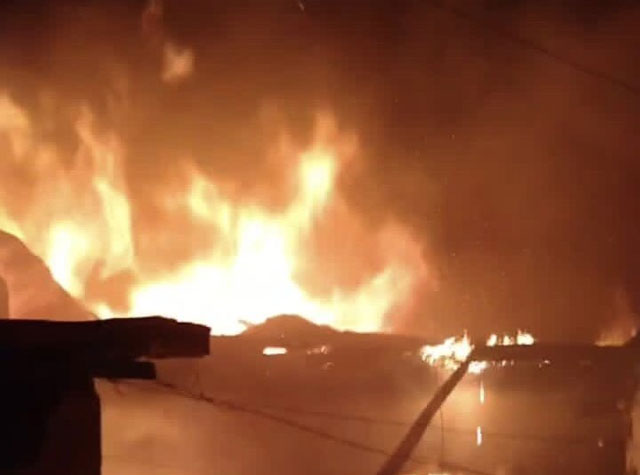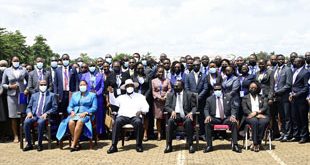
Kampala, Uganda | THE INDEPENDENT | Only about 35 percent of the boarding schools in the country have complied with fire safety guidelines, URN has learnt.
Dr. Denis Mugimba, the spokesperson of the Ministry of Education and Sports disclosed this to URN in an interview about the latest fire incidents in schools.
On Sunday night, fire gutted two boys dormitories at Bilal Islamic school in Kawempe division, Kampala. This was the tenth fire incident reported in schools in the last seven weeks since schools resumed operation following the unprecedented closure triggered by the COVID-19 pandemic.
At least more than six learners were killed, several others injured and property lost in the school fires. Dr. Mugimba says that they are concerned that school dormitories have become death traps for learners.
In 2008, following the fire that gutted the dormitory at Buddo junior school and killed 21 learners, the Ministry of Education and Sports in collaboration with the Uganda Police Force drafted fire safety guidelines.
These included among others that each school should install fire alarms, fire extinguishers, fence the school premises to lockout strangers, remove the burglar proofing in doors and windows, eliminate the use of triple-decker beds and ensure that dormitories have multiple exit routes.
Despite years of vociferous debate and repeated calls for the government to improve its inspection regime, the fire incidents have continued. Dr Mugimba partly blames this on school administrators whom he says have failed to adhere to standards and only remember them when tragedy has befallen them.
Observations from Bilal Islamic schools indicate that the burnt dormitories were crowded with triple-decker beds with very minimal space between them. Learners have to crawl across several beds to reach their own.
“It was luck that learners were not in the dormitories at the time of the fire. If there were children they could easily be trapped in this kind of arrangement,” one of the police officers who rushed to assess the damage said.
Besides, some children told URN at the scene that there were no fire extinguishers on the school premises. This was the same observation when fire gutted Good Times infant school in Kawaala a week earlier leaving one pupil dead.
The two schools are 2.1km apart. Parents like Aisha Kalanzi of Kawempe, wonder why the ministry allows schools to operate in the first place when they don’t meet the minimum standards.
“When a school is registered and licensed, we the parents assume that they have ticked every box and we feel sad when these officials come out to say that some schools don’t meet standards. For us we don’t know the standards, we just ask whether the school is licensed,” Kalanzi said.
The parent’s argument triggers an interesting debate given the findings in a respect inspection report compiled by education authorities at KCCA, which shade a rosy picture on the status of schools after reopening.
KCCA noted that all schools had met the minimum requirements without listing some of the things like crowding, which is a public secret. Other officials who are also put in the spotlight because of the fires are local government officers who approve school structure developments, electricity distributors and police safety inspectors whose reports are also critical during the licensing of any school.
The State Minister for Primary Education Joyce Kaducu, says that truth be told, during school reopening, many inspectors focused on the Standard Operating Procedures put in place to contain COVID-19 and ignored the old guidelines.
Aminah Mutesi, the Jinja city education officer defends inspectors noting that they always perform their tasks whenever they visit schools. She says that after inspection, they write reports and give recommendations to schools but in many instances, administrators don’t bother to implement them.
Mutesi also adds that due to limited funding, at times inspectors fail to return to these schools to find out whether the recommendations were implemented.
However, a headteacher in Wakiso district who preferred anonymity noted that the inspection function is largely a formality since many inspectors don’t ever show up at school but fill reports from their offices.
“Inspection is a money-making venture for education officials, most headteachers part with kickbacks, and take visitors books to district headteachers for the inspectors to sign,” the headteacher noted.
Stella Nambozo, an education manager who is also the second vice-chairperson of the Headteachers Association of Uganda, notes that there are other neglected factors in school fires like demotivated and underpaid staff plus angry learners.
Nambozo’s theory can be traced to the 2019 fire at Namirembe hillside where students told police that they had started the fire as a means of putting out their anger for corporal punishment and poor feeding.
Referring to the same circumstances, Minister Kaducu says schools should ensure there are spot checks for learners and also ensure that they don’t stay unsupervised in the dormitories.
Security personnel often blame school fires on electrical faults and sometimes arson. Police investigations take years and are seldom completed.
*****
URN
 The Independent Uganda: You get the Truth we Pay the Price
The Independent Uganda: You get the Truth we Pay the Price



I do not know who is responsible for this activity: there is something called risk assessment
When risk is identified one implements mitigation measures
Each student/ pupil of primary 5 and above should have an idea about fire
Fire training is conducted by knowledgeable people
Other than the theory. The right age group is taught about fire extinguishers( the types, purpose and how to use)
These look to be far fetched, but some fires can be prevented, while others can be stopped before they spread
It also becomes self defeating when the fire exists are blocked or the vehicle arrives and the entry is blocked by a car ( it becomes a
parking site)
From the old schools we learnt “accidents do not just happen, they are caused by carelessness, poor work habits or faulty equipment”
A unit with frequent fire drills will identify, missing fire extinguishers/ empty fire extinguishers, obstructed fire exits etc
Some parents do due diligence and avoid schools with overcrowded dormitories
Let the training be as frequent as sports activities